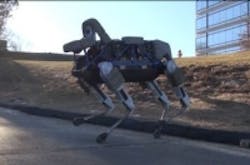Smaller, more nimble quadruped robot unveiled by Boston Dynamics
Google-owned Boston Dynamics has developed a new vision-guided quadruped robot called "Spot," which is designed for indoor and outdoor operation and has a sensor head that enables it to navigate and negotiate through rough terrain.
Spot, which weighs about 160 lbs., looks similar to Boston Dynamics’ BigDog military robot—a 240 lb. robot that has an integrated stereo vision system and a LIDAR system developed by NASA's Jet Propulsion Laboratory. The system can interpret the shape of the 3D terrain in front of the robot, and find a clear path forward. Though no information beyond a YouTube video of the Spot robot has been released, it can be assumed that the robot’s vision system is similar to that of the BigDog. In addition, when watching the video, you can see what appears to be a Velodyne LIDAR system spinning on the robot’s head.
BigDog’s purpose is relatively clear, in that it is a rough terrain robot that can carry a 340 lb. load at 4 mph and climb slopes up to 35°. In addition, DARPA awarded Boston Dynamics a $9.9 million contract to develop an advanced version of the BigDog, the LS3. In doing so, Boston Dynamics sought a military robot with increased reliability and usability, enhanced survivability against small fire arms, and a quiet power supply to support stealthy tactical operations.
So, what exactly will the battery-powered Spot be used for? It could still be for military use, but as of now, the answer is not clear. What is clear to me, however, is the rapid and exciting development of autonomous robots like Spot. In my 30+ years on Earth, I’ve witnessed an almost unfathomable period of rapid and impressive technological advancement; from early MS-DOS-based PCs to robots that can autonomously compensate for being kicked hard in the side (see the video, if you are confused.)
Robots like Spot can obviously evoke conversations about the technological singularity, but that is a conversation for another day. Instead, I thought I would leave you with this thought-provoking quote, which I read in the January issue of National Geographic.
“Since technology grows exponentially, not in a linear way, we will see dramatic improvements in our way of life in just a few years. Though it took us 4,000 years to get from the abacus to the iPad, in 20 years we will have something as far ahead of the iPad as it is ahead of the abacus. This means that soon we will be able to solve all problems that are fundamentally technical. These problems include disease, poverty, hunger, energy, and scarcity.” - Byron Reese, Tech Entrepreneur
View an IEEE Spectrum article on SPOT.
Share your vision-related news by contacting James Carroll, Senior Web Editor, Vision Systems Design
To receive news like this in your inbox, click here.
Join our LinkedIn group | Like us on Facebook | Follow us on Twitter | Check us out on Google +
About the Author

James Carroll
Former VSD Editor James Carroll joined the team 2013. Carroll covered machine vision and imaging from numerous angles, including application stories, industry news, market updates, and new products. In addition to writing and editing articles, Carroll managed the Innovators Awards program and webcasts.
